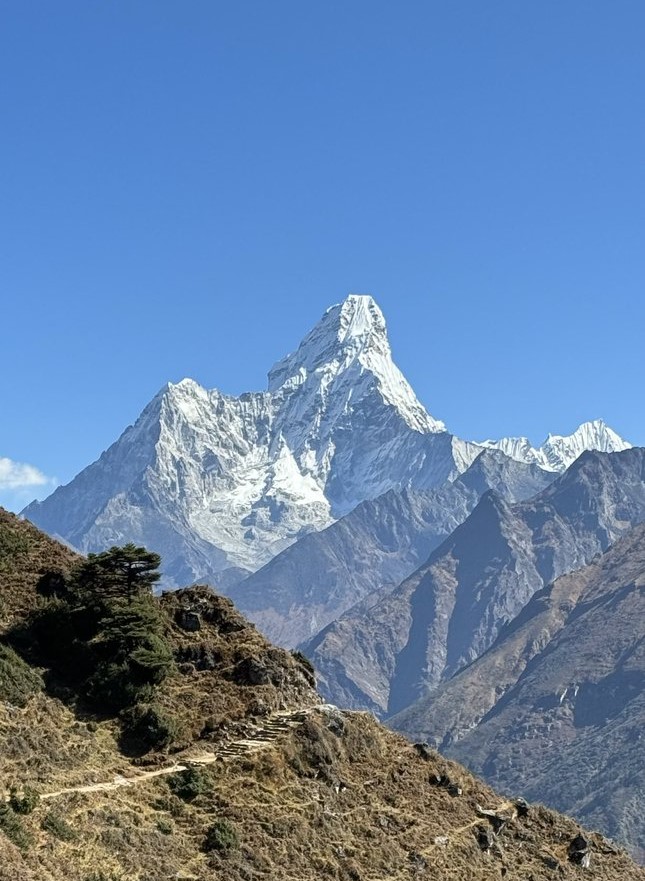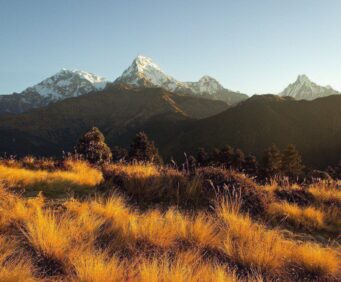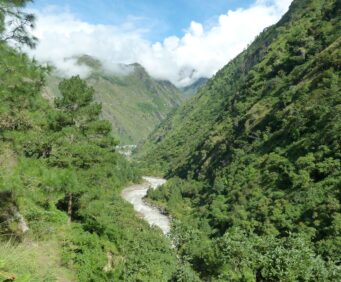
What are technically difficult mountains in Nepal?
2nd June, 2024 - Posted By: Himalayan AbodeThe country geographically located in the lap of the Himalayas has many mountains that can be considered as hard and technical even for experienced climbers. These peaks lure climbers from around the world offering the sheer copy of reaching the top and the technicality and complication involved in doing so. Nepal is represented as the home of the technically demanding and most challenging mountains on earth. Here, you can know a few of Nepal’s most technically difficult mountains.
The most technically difficult mountains in Nepal
1. Mount Everest (Nepal-Solu-Khumbu, Nepal-Tibet (8,848.86 meters/ 29,031 feet))
Mount Everest is considered the highest peak of the Earth which many people desire to climb. Nevertheless, it is not only the problems of height that make a problem in the climbing of Everest; there are technical difficulties also.
Mt. Everest presents significant challenges due to its altitude, and unpredictable weather, and the Khumbu Icefall, another glacier, filled with loose seracs and frequently changing crevasses of various depths, is considered to be the most dangerous part.
Treading across this jumble of ice blocks is quite a challenge and one has to use ladders and ropes to get past the ice blocks especially if one has a weakness for heights that will need some nerve to overcome!
A little higher l in the climbing route is the Hillary Step; a steep, 40-foot rock face before the summit. Climbers have to face this technical route at an altitude where oxygen is extremely scarce, and the climbers find even basic movements a real struggle.
2. Lhotse – 8,516 meters/27,940 ft
There are some similarities between Lhotse’s route and that of Mount Everest the world’s fourth-highest mountain. Though only 5.7, it has presented with a great deal of challenge in the last pitches and has amazing exposure. This area includes giants like the Lhotse Face—a steep wall of glacial blue ice stretching directly up at 40 to 50 degrees. They have to kick and chop the ice to build steps for themselves and this is so strenuous especially due to the altitude.
3. Kanchenjunga – 8,586 meters/28,169ft
Kanchenjunga is the third tallest mountain in the world and is considered more challenging than other tallest mountains due to technical difficulties, harsh climate, and accessibility. Owing to the often occurring avalanches and the technicalities involved in climbing on its location, five summits make it one of the most demanding peaks to climb in the Himalayas. Vertical ice at times contains ledges and other times gives a knife ridge formation which is a challenge to many climbers even at the professional level.

4. Makalu – 8,485 meters/27838 ft
Makalu has the looks of a pyramid-like mountain with sharp gables and promises to present a series of technical difficulties. The summit is reached by climbing with both rock and ice institutes and the final stages of the climbing are particularly challenging due to the steepness of the slope and exposure of the face.
Mt. Maklu is one of the most challenging 8000-meter peaks, it requires advanced technical climbing skills. It should be understood that climbers will face a very challenging climb that would require an extensive level of technicality and fitness.
5. Annapurna I -8,091meters/ 26,545ft
Annapurna I is one of the highest peaks in the world with a height of 8,091 meters.
It is often termed as the most dangerous mountain among the 8000-meter high mountains owing to its steep slopes and high altitude range. The ascend itself includes moving on thin and slippery snow and ice cliffs and because of the frequent avalanches, the climb is very dangerous.
There are several technical parts of climbing the mountain and the unpredictable occurrence of avalanches makes Annapurna I a difficult task for anyone who sets out to scale the mountain.

Read for more about ABC
6. Dhaulagiri – 8,167 meters/26,795 ft
Dhaulagiri is documented as being subjected to extremely unfavorable climates and geographical environments. It is mostly rope-scary, with pinnacles cod with ice ranks.
Its remote location also represents the technically difficulty climbing peak. A change in weather, especially when it comes to moving from a tropical zone to a higher altitude, makes it compulsory that climbers are always on standby and ready to set off at any one time owing to the technical aspects which are required for climbing the mountain.

7. Manaslu – 8,163 meters
Although being the eighth-highest peak in the world, it has steep technical terrain especially when crossing icy slopes and has large crevasses. Due to its unsafe topography, climbers need to have high-level technical skills to undertake it.
Climbing to the peak of Manaslu is not only a test of one’s physical prowess but also one’s mountaineering skills and an assessment of the risks and challenges that one is likely to encounter on the climb.

8. Ama Dablam- 6,812 meters/ 22,349ft
Ama Dablam is the shortened form of Ama Dablam Tsenji and it rises to a height of 6,812 meters. Looking at Ama Dablam, it is clear that, despite the fact it has no 8000-meter plus altitude, it is quite difficult. With its sidereal peaks, sharp ice veins, and rocks it requires a fair amount of special knowledge on the part of mountaineer.
The climb is technical and requires the climber to navigate through cliffs and find good holds in some parts; this makes it a favorite for climbers seeking a thrilling time when on a climb.
9. Pumori – 7,161 meters
Pumori is the other difficult mountain near Everest to attempt to get to the top of it. It has frozen pillars to ascend and face several rock passages as well as serious rock climbing with total exposure. Pumori has many similarities with Mount Everest and, therefore, climbers use it as a training ground for climbing the main peak of Lhotse’s neighbor.
10. Baruntse-7,129 meters/ 23,389ft
It is also one of the technically difficult mountains, which involves steep ice and snow climbing, crevasses, and technical ridges.
11. Cho Oyu-8,188meters / 26,864ft
Cho Oyu represents the technical challenges of peaks, especially near the summit where climbers face steep ice and rock.
What makes these mountains difficult to climb?
The mountains of Nepal are well known for their technical difficulties hence making them difficult to climb because of the various aspects for instance technical challenges, poor weather conditions, high altitude, and the inherent risk that is occasioned by the various terrains. Here’s a detailed look at what makes each of these mountains particularly challenging: Here’s a detailed look at what makes each of these mountains particularly challenging:
Altitude
If adopting the strategy of undertaking more climbing at higher altitudes, it is important to note that the air becomes thinner, and every step becomes a task and more so comes the increased probability of contracting altitude sickness.
Steep Ice and Rock Sections
Needless to say, the route is severely technical and features extended mixed ice and rock climbing sequences.
Exposure
The climbers are exposed to the climatic conditions, making them vulnerable to getting frost bite and hypotherm.
Some of the common challenges that face people when attempting such cross-mountain routes include the following:
Altitude
High Altitude: These are all extremely high altitude mountains where the pressure is low and the supply of oxygen uncommonly limited. It opens up chances of getting altitude illness, such as acute mountain sickness (AMS), high altitude pulmonary edema (HAPE), and high altitude cerebral edema (HACE), among others.
Weather
Severe Weather Conditions: The day-to-day weather of the Himalayas is characterized by extreme dampness and uncertain weather patterns. Extreme conditions include sudden storms, quick and strong winds, extreme cold temperatures which make climbs painful and difficult, and often times, climbers have to quit even though they are only a few hundred feet away from the summit.
Terrain
Complex and Steep Terrain:
Bear in mind that thick sharp icicles, seracs, crevasses, and rock walls require enhanced technical climbing from the climbers. I specifically remember that walking these terrains requires accurate movements of the body and the knowledge of how to use pieces of gear needed for climbing.
Avalanches: Most of the mountains associated with these earthquakes are precipitous and result to avalanches which are most of the time fatal.
Logistics and Support
Remote Locations: Most of these peaks lie in the less accessible regions, often deep in forests or set high up in difficult-to-climb terrains. This makes logistics more complicated and the delivery of aid and conducting rescue operations in case of an emergency will be slower.
Limited Rescue Operations: The elements and most of the time the places are extremely unfriendly which exposes the climbers to many dangers and when mishaps occur rescue is often very difficult and quite limited.
Conclusion
Climbing these technically difficult mountains in Nepal goes beyond the ability to ford the body physically; it also involves mastering several techniques, strength, and keen readiness mentally. The promised summits of these mountains are a sequence of designs, and this has minor crevasses and icefalls, steep rocks, and ridges to overcome.
As so often the case with such fascinating challenges, those willing to take on these difficult mountains find themselves rewarded with the following possibilities: the feeling of accomplishment, a view into the great beyond, and the experience of standing on one of the most difficult terrains of the entire world.
For those that want to love mountaineering or dream of high-altitude climbs or are wishing for their first expedition to the high peaks of the world, then Nepal has technically the most challenging mountain to enjoy some of the most striking climbs in the world.
Key information to counteract includes always hiring the services of qualified guides, proper acclimatization to the environment, and lastly, not underestimating the authority of these massive mountains.
Recent Posts



